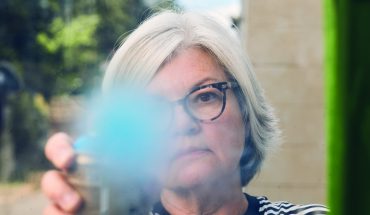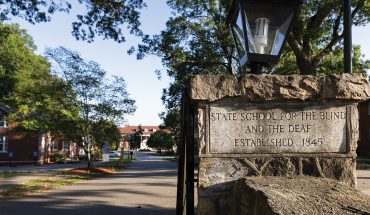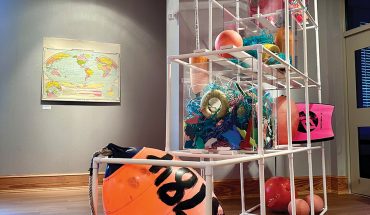
Artist and landscape designer Preston Montague poses for a portrait at the Eno River in Durham on Monday, July 31, 2017. Montague’s inspiration comes from his deep connection with nature. “Everything that I do is a water story,” he says. “In the water was when I was the most free. I felt like I could fly.”
Cover Artist
Botanical Illustrator Preston Montague
by Liza Roberts
photograph by Madeline Gray
Botanical illustrator Preston Montague was already considering which native North Carolina plants he might include in his drawing of the letter W for his Codex Carolinum alphabet series when Walter called, asking if he would consider drawing the letter W for the cover of our fifth anniversary issue.
“It’s a coincidence that Walter magazine came along at exactly the right time,” he said one recent evening from his home in Durham, where he spends his weekdays designing landscapes at Lift Environmental Design, and his mornings, evenings, weekends, and vacations teaching and studying and depicting the nature around him.
For the alphabet series he began four years ago (15 painstakingly created letters down; 11 to go), Montague chooses native or naturalized plants of North Carolina that have traditionally been used for food or medicine to shape what he describes as “didactic” drawings that employ “art and storytelling to explore relationships between the state’s plants, animals, and people for the purpose of encouraging natural science literacy.”
It’s a literal description, but one that fails to note the delicate beauty of his drawings, the whimsy of his sensibility, or the symbiotic insects, birds, and animals that turn each letter of his alphabet into an object of enchantment.
In an artful tangle of his M’s maple leaves, for instance, lies a stealthy, translucent jade moth; an entire nest of hummingbirds – and a honeybee – make a magical home in his Rhododendron-woven R; a happy toad sits plumply above a nest of ants under his Trillium-shaped T. These creatures were not originally part of his alphabet plan, he says. “This was supposed to be a strict botanical project. But every time I do one of these botanical letters, I have a visitation. So every time, I include an animal I’ve been visited by” while sketching en plein air at a “gorgeous spot” in the Nantahala National Forest where he finds his subjects. “It’s my Notre Dame, it’s my mecca, it’s the place I take pilgrimages to, on Wolf Creek, in a temperate rain forest. It’s one of the places I consider to be magic.”

Originally, Montague says, he considered using water lilies to make his W, because he wanted to use an aquatic plant. “But in my heart, I wanted it to be witch hazel. Not only is it beautiful and bizarre, but it’s a plant we all have access to in our grocery store. Also, when contacted by Walter, I had another serendipitous experience: I had my first encounter with a baby owl in a witch hazel plant.” He even saw that there were W-shaped designs in the owl’s feathers. “So: witch hazel and the baby owl.”
The biggest challenge with W, he noted, was making it back-lit. He wants his letters to begin in morning and end at night, so W had to capture waning light. The result is beautiful, but Montague is equally committed to the larger purpose of educating with his works. Using art and storytelling to teach natural science is a calling, he says: “Getting folks in the 21st century excited about nature” is important to him, especially “visual learners like me who feel left behind, or left out.”
It’s a goal Montague never could have imagined when he graduated from UNC-Greensboro with a degree in painting; it’s nothing he thought he’d be working on when he put painting aside to study landscape architecture at N.C. State. But there was a moment long ago, one he remembers in technicolor, that might have foretold his future focus: It was a summer day on his grandparents’ Ashe County farm; he was merely 3. He waded out into Little Horse Creek and flipped a brown rock. “Underneath was a red salamander. It exploded my concept of reality. It was terrifying to the both of us. There’s a metaphor there, with lifting the rock up, and revealing another world, and another creature, that has stuck with me. And I think I am still chasing that feeling.”



